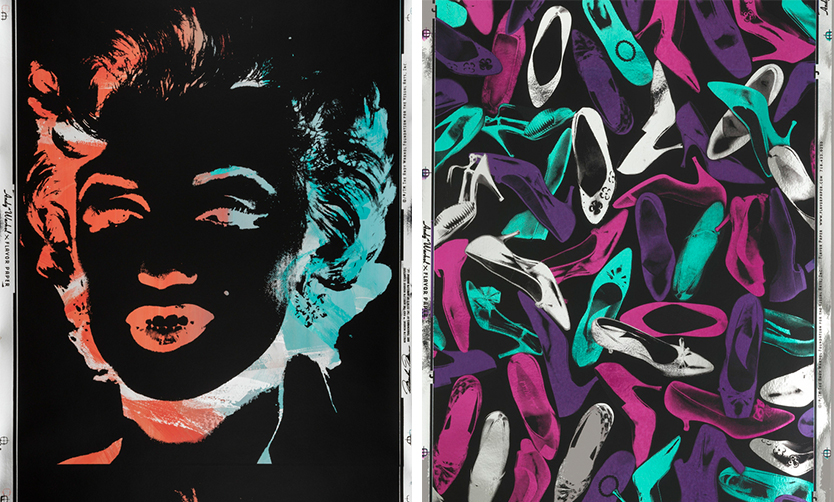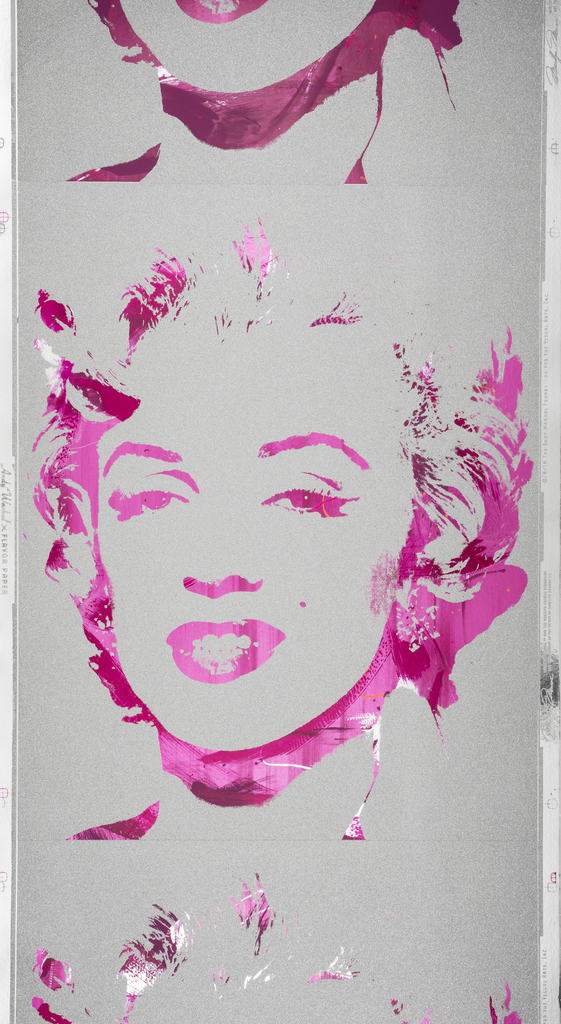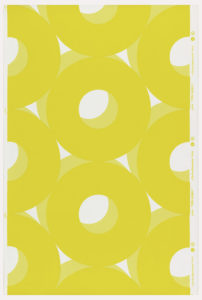Pop art is fun! Coming out of the 1950s and ‘60s, the artistic style plays with elements and imagery of domestic life, consumerism, and popular culture. The style was contemporaneous with the emergence of the mainstream gay rights movement in the United States and cultural evolution of queer identity in the late 1960s.
Starting with pop art, this selection of wallpapers by or inspired by LGBTQIA+ artists and designers from Cooper Hewitt’s collection also looks to other trends of the 1960s and ‘70s, such as craft, supergraphics, and psychedelia.
Marilyn
Sidewall, Marilyn Monoprint, 2015
After Andy Warhol (American, 1928–1987)
Manufactured by Flavor Paper (Brooklyn, New York, USA, founded 2004)
Screen printed and hand painted on chrome Mylar, polyester diamond dust
457.2 × 74.9 cm (15 ft. × 29 1/2 in.)
Gift of Flavor Paper, 2015-44-3
Who? Inspired by one of Warhol’s most well-known paintings of one of the most famous people in American culture, this paper pays homage to the iconic Marilyn Monroe and Warhol’s depiction of her image. The hot pink color echoes Warhol’s dominant palette and the metallic Mylar harkens back to a midcentury American aesthetic of shiny metals and plastics.
Cooper Hewitt possesses Marilyn in another colorway, as well as a paper based on a Warhol drawing of shoes, a nod to his start as a graphic artist in advertising.

Sidewall, Marilyn Monoprint, 2015
After Andy Warhol (American, 1928–1987)
Manufactured by Flavor Paper (Brooklyn, New York, USA, founded 2004)
Screen printed and hand painted on chrome mylar
457.2 × 74.9 cm (15 ft. × 29 1/2 in.)
Gift of Flavor Paper; 2015-44-4
Sidewall, Shoes, 2013
After Andy Warhol (American, 1928–1987)
Manufactured by Flavor Paper (Brooklyn, New York, USA, founded 2004)
Screen print on mylar
457.2 × 75.2 cm (15 ft. × 29 5/8 in.)
Gift of Flavor Paper, 2015-44-2
Cherry Forever
Sidewall, Cherry Forever, 2007
Designed by Michael Angelo (American, born 1970)
Manufactured by Flavor Paper (Brooklyn, New York, USA, founded 2004)
Screenprinted Mylar foil, microencapsulated scented oils
457.2 × 75 cm (15 ft. × 29 1/2 in.)
Gift of Flavor Paper and Michael Angelo, 2007-36-1
“Brooklyn-based wallpaper company Flavor Paper produced the first scratch-n-sniff wallcovering in 2007 with Michael Angelo, a celebrated hairstylist whose Wonderland Beauty Parlor in New York City features mirrored walls, a fuchsia settee, and a Mylar waterfall dotted with Barbie mermaids. Among their scratch-n-sniff wallpapers is Cherry Forever, a pop art homage of glossy red cherries on a yellow chrome background. The wallpaper is hand-printed and seeded with microcapsules of fragrant oil. When a user rubs the cherries on the wallpaper, the capsules break open to release the scent—a celebration of the effervescent fifties, a full-fruity embrace of the synthetic cherry fragrance.”
—Andrea Lipps, The Senses: Design Beyond Vision (Cooper Hewitt and Princeton Architectural Press, 2018)
LiFe Saver
Sidewall, Life Savers, 1970–80
Designed by Alan Buchsbaum (American, 1936–1987)
Manufactured by Norton Blumenthal, Inc.
Screen-printed vinyl
113 × 75.5 cm (44 1/2 × 29 3/4 in.)
Gift of Alan Buchsbaum, 1980-66-2
“Aptly titled Life Savers, this wallcovering enlivened the interiors market sometime in the early 1970s. The design consists of circles, or life savers if you will, tightly aligned in polka dot fashion. The front of each circle is printed in an intense yellow, with slightly lighter yellow sides, which visually creates relief. . . . Alan Buchsbaum was an architect and designer, whose career took him through the supergraphics look of the 1960s (he is said to be one of the originators of this style), to the high-tech aesthetic of the 1970s, and the loft look popular during the 1980s.”
—Greg Herringshaw, “Wallcovering for Your Sweet Tooth” (Cooper Hewitt, 2019)
Bullies
Sidewall, Bullies, 1992
Designed by Virgil Marti (American, born 1962)
Screen-printed Tyvek, rayon flock
574 × 138.5 cm (18 ft. 10 in. × 54 1/2 in.)
Museum purchase from General Acquisitions Endowment and Friends of Wallcoverings Funds through gift of the Raymond Family in honor of Paul Raymond, 2002-4-1
“The tension between ‘good taste’ and ‘bad taste’ permeates Marti’s work. In Bullies, the wallpaper’s pattern is an appropriation of the eighteenth-century French toile motif, which typically boasts vignettes of pastoral figures embedded in leafy, flowery frames. But Marti intentionally bastardizes this traditional pattern, saturating the color palette to a garish flamboyance with Day-Glo inks, burdening the visually busy surface texture with black velvet flocking, and maintaining the boys’ 1970s hairstyles. In doing so, he feminizes the boys and questions our attachment to the status of objects, however we encounter them.”
—Matthew Kennedy, “Framing the Bullies” (Cooper Hewitt, 2020)
Moo
Sidewall, Cow, 1971
Designed by Andy Warhol (American, 1928–1987)
Printed by Bob Miller’s Wallpaper Studio
Screen printed on paper
348.5 × 75.5 cm (137 3/16 × 29 3/4 in.)
Gift of Andy Warhol, 1980-69-1
“Cow was first shown at the Leo Castelli Gallery in New York in 1966, which must have caused quite a stir. The exhibition consisted of two galleries: the first was empty save for the installation of Cow wallpaper printed in fuchsia on a bright yellow ground. The second gallery contained large silver helium balloons shaped like bed pillows, aloft at various levels. . . .
“Warhol designed a total of five wallpapers over the course of his career. Besides Cow, there was Chairman Mao, The Washington Monument, a self-portrait, and one of fish. Designing wallpaper seems like a logical step for Warhol to pursue, as he frequently displayed his artworks in row or grid formations, which gave the appearance of wallpaper. All of his wallpapers repeated in a similar fashion.”
—Greg Herringshaw, “Deja Moo” (Cooper Hewitt, 2019)
This paper was adapted into a shopping bag accompanying a Warhol retrospective at the Museum of Modern Art in 1989. Do you need a bag? Moo!
Shopping Bag, Andy Warhol: A Retrospective, 1988
Featuring artwork by Andy Warhol (American, 1928–1987)
Client: The Museum of Modern Art (New York, New York, USA)
Paper
45.7 × 30.5 cm (18 × 12 in.)
Gift of Judith G. Bergoffen, 2000-53-14
Herringbone
Sidewall, Chopped Herringbone, 1971
Designed by Alan Buchsbaum (American, 1936–1987)
Manufactured by Norton Blumenthal, Inc.
Screen-printed on vinyl
135 × 75 cm (53 1/8 × 29 1/2 in.)
Gift of Alan Buchsbaum, 1980-66-1-b
Chopped Herringbone plays with the classic herringbone pattern of successive “v” shapes to create a graphic, whimsical pattern of relaxed geometries. The muted color palettes of the colorways anticipate the more earthy tones popular in the 1970s.
Love
Sample Book, Combined Edition II, 1969
Designed by Jack Lenor Larsen (American, 1927–2020) and William Skilling (American, born 1940)
Manufactured by Karl Mann Associates
Screen-printed paper, vinyl
Overall: 51 × 36 × 4 cm (20 1/16 × 14 3/16 × 1 9/16 in.)
Gift of Karl Mann Associates, 1969-132-1-1/57
“Jack Lenor Larsen was one of the foremost American modern textile designers. Like many designers, he branched out of his expected medium for collaborations. In this book of wallpaper samples designed with William Skilling for Karl Mann Associates, Larsen used a similar bright, bold color palette often found in his textile designs and abstract forms displaying a handmade imperfection. He was an advocate for the role of craft in modern design in a career spanning seven decades.”
—Matthew Kennedy, “Queer Modernisms and Beyond” (Cooper Hewitt, 2023)

Matthew Kennedy is the Publications Associate at Cooper Hewitt and History & Collections Chair of Smithsonian Pride Alliance. He has nothing to do with the museum’s wallcoverings curatorial department, but thinks they are some of the most fun objects in the collection and deserve more attention.













